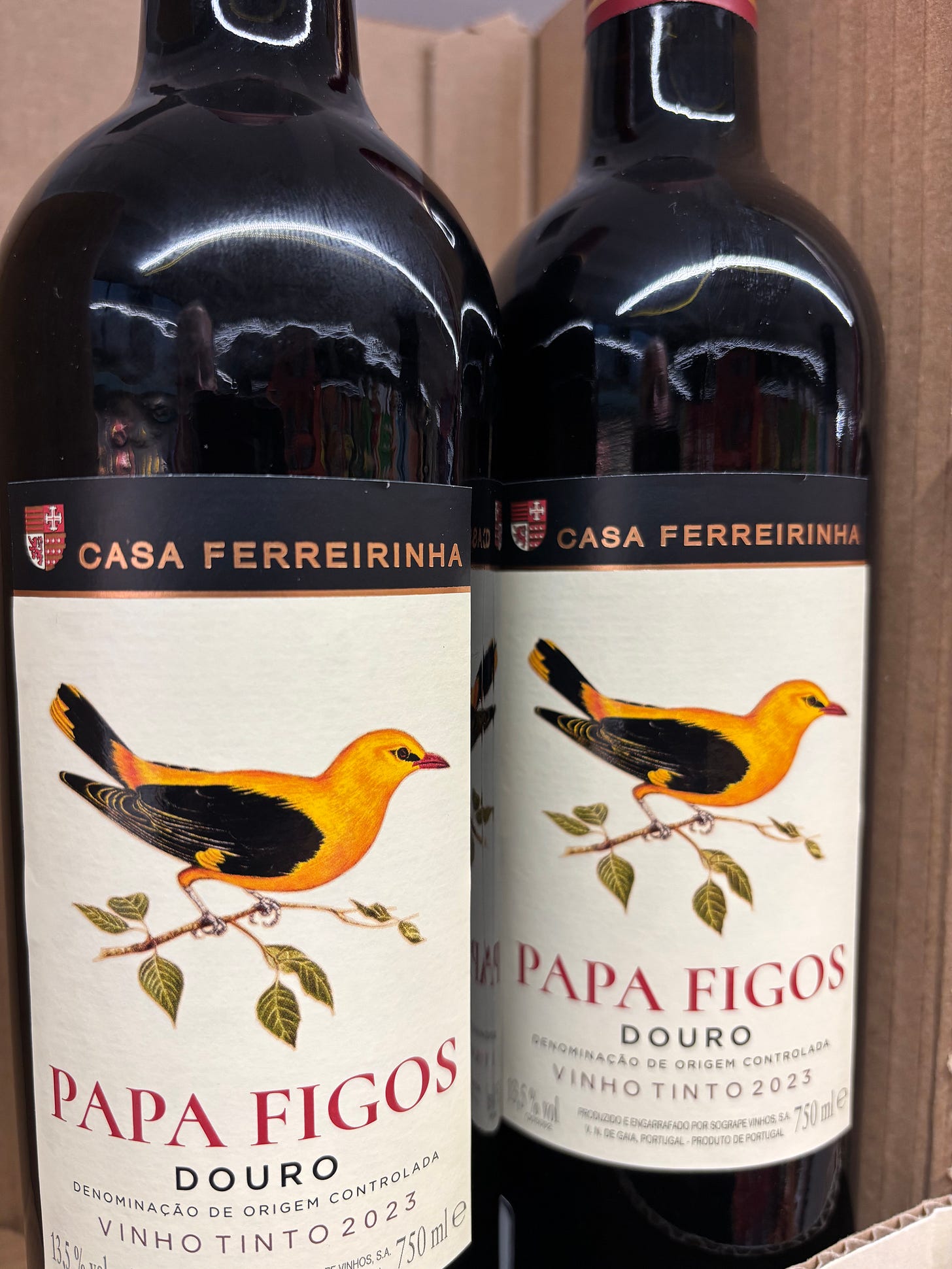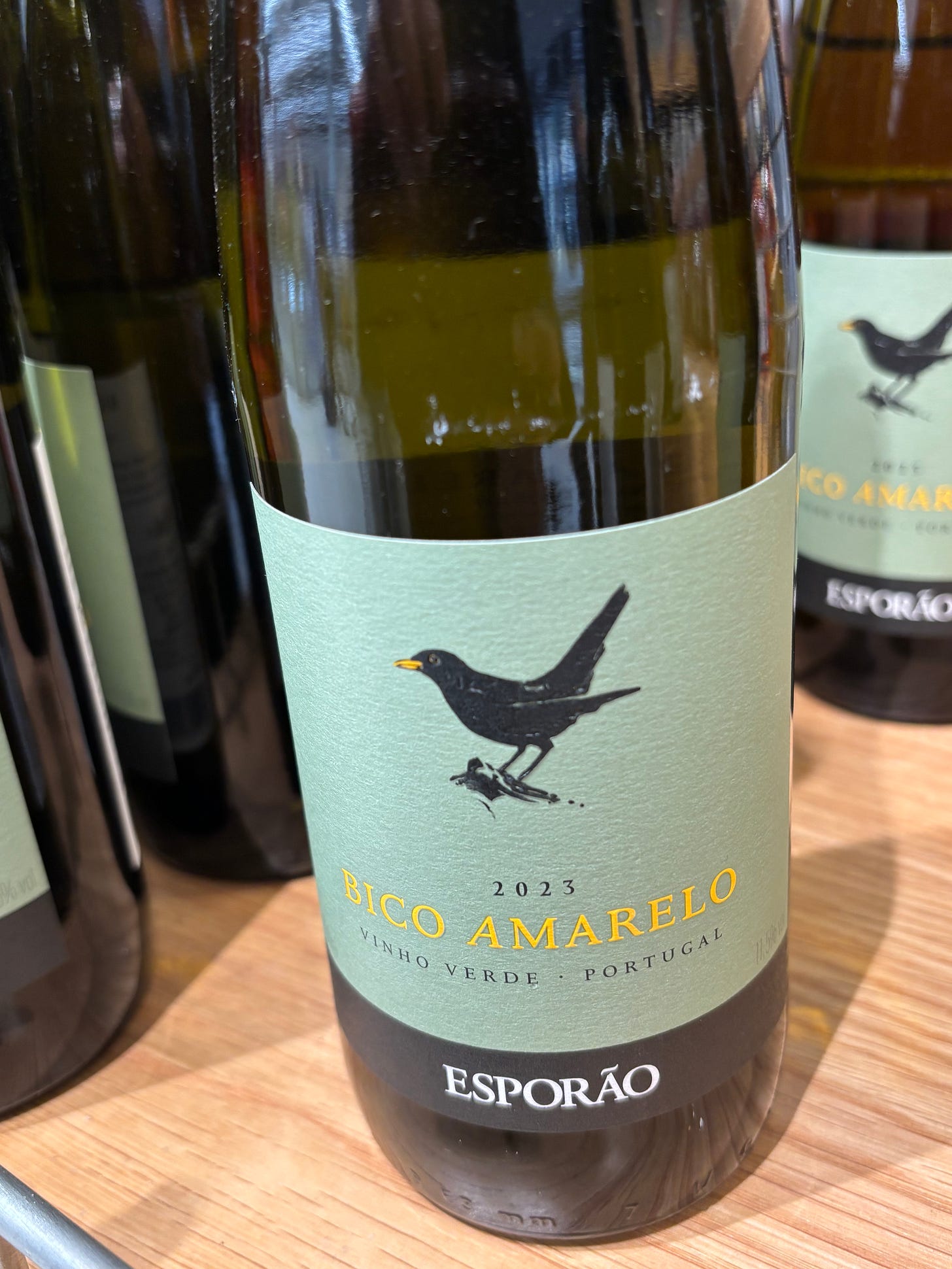Why Are There So Many Birds on Portuguese Wine Labels?
Stick around to find out—or not, because I’m still figuring it out myself.
Hello dear reader, and welcome to the first of many unplanned and unscheduled posts that I’ll be sending your way from my new publication. The only thing I can promise at this point is that you won’t receive more than two posts a week and no fewer than one a month—the rest, I’ll figure out as I go. I hope you’ll stick around for the ride, at least for a while, and feel free to bring a friend along.
I want my Substack to feel like the way I like hosting friends—you can always bring an extra guest, and even if I don’t have a set menu, I know I’ll cook up something palatable, possibly even delicious, for you.
The one piece of advice my PhD supervisor gave me before I embarked on 18 months of fieldwork in urban Burkina Faso was: Do not take anything for granted. Be curious about everything. He didn’t go on about fieldwork methods—he simply told me to observe and question what I encountered. And so I did. And I still do, even in my everyday life.
Sometimes, when I move to a new country, I become intrigued—or even somewhat obsessed—with a strange detail, an element of material culture, some small thing that locals don’t seem to notice. But I feel like there must be a story behind it. And so I go down the rabbit hole, trying to learn more, to uncover the story behind the thing. Sometimes, I figure it out; other times, I come up empty. But even then, that small detail keeps feeding my curiosity.
This is the first short post in a series where I follow what seem like breadcrumbs—chasing something that fascinates me, even if it turns out to be completely unconnected to the thing that first sparked my interest. I am calling it Unexpected Obsessions: Following the Trail of Fascinating Little Things and I am working on the technical side of that.
So, you may be thinking—what does this have to do with birds on Portuguese wine labels?

Remember the saying, “Don’t judge a book by its cover.” Well, the same probably applies to wine labels. But marketers know that people do, and will continue to, judge wine by its label. And I am one of those people. I also like birds. I enjoy birdwatching (even though I’m not very good at it, as I’ve written in my other publication) and love bird-related art.
When I first arrived in Lisbon in November 2022 for a three-month exploratory stay, several wine-related things struck me: first, the sheer number of grape varieties in Portugal, many of which I had never heard of; second, the vast number of Portuguese wine companies; and last but not least, the surprising number of wines featuring birds on their labels. And that’s what I want to talk about today.
I’ve always had an eye for attractive packaging, and wine labels are no exception. Birds on wine labels often make for beautiful designs. As I started noticing these wines, some of them featured my favorite birds—like a blackbird (bico amarelo), a bee-eater (abelharuco), a hoopoe (poupa da serra), and a European jay (gaião). Naturally, I began to wonder why birds were so prominent on these labels.

So, there I was in late 2022, thinking about this topic and informally interviewing wine sellers at variours garrafeiras. The answers I got were usually superficial: “Oh, they’re pretty,” or “Portugal has a lot of birds.” But that didn’t quite add up—I found no evidence that Portugal has more birds1 or birdwatchers per capita than other wine-producing countries in Europe or elsewhere.
Fast forward to February 2025, when I decided to do some more “serious” research on this topic (meaning I spent an hour Googling “birds on wine labels” in English and Portuguese). And I did make some interesting discoveries. For example, an article published in November 2022 in The Journal of Food Distribution Research found that among wines distributed in the U.S., animals appeared on 16.7% of wine labels, with birds being the most frequently depicted, appearing 8.9% of the time. Yet, in only 10% of cases did the wine label mention an environmental connection between the bird and the wine. Mostly, these labels are just marketing gimmicks. I haven’t found any similar statistics for Portugal, and unless one of my readers wants to fund such a study, I won’t be going down that rabbit hole.
However, I did make some other observations about birds on Portuguese wine labels. They appear on both very cheap wines (as low as €1.50 per bottle) and higher-end wines (€15 and up). So, the birds are for everyone. Some wines with beautiful labels, like Bico Amarelo, aren’t particularly great, while others, like Herdade dos Grous, can be quite good. Some of the wine makers, as the aforementioned Herdade dos Grous2 or Louis Pato have a bird in their name. There also seems to be a prevalence of waterfowl on these labels, which makes me think about the connection between vineyards and hunting areas (unfortunately, wildlife hunting is still quite widespread here). In the absence of a detailed study, I’d say most labels feature birds simply because they help sell wine.
That said, some winemakers (and the designers they collaborate with) make an effort to highlight biodiversity in their vineyards. A great example is award-winning wine designer Rita Rivotti, who worked with Companhia das Lezírias to create a label for their wine Tyto Alba (Barn Owl). The company is actively involved in environmental projects, including one focused on barn owl conservation. This initiative involved placing nest boxes throughout the forest, allowing young owls to be ringed and fitted with radio transmitters for study and protection. As a result, the resident barn owl population grew significantly, becoming one of the largest in the world. The Tyto Alba wine even comes in a wooden box that can be repurposed as a nest box. How neat is that?
Even though the U.S. study found that most wine labels don’t explicitly connect the featured birds to the wine region, it’s clear that birdlife does impact wine production—and vice versa. Recently Portuguese journalists noted that rising temperatures in Southern Europe are causing many migratory birds to forgo their usual journey to North Africa, instead staying in regions like the Alentejo, where they feed on grapes and negatively impact wine production. At the same time, research shows that in many wine-growing regions, birds outperform pesticides when it comes to pest control.
So, what’s my mini, non-scientific conclusion after this little exploration of birds on wine labels? Yes, they’re pretty, and I, for one, have been tempted to buy a bottle based solely on the label. But beyond aesthetics, there’s a deeper connection between birds and wine production. I look forward to learning more about the environmental impact of Portuguese wine producers on local and migratory birdlife.
Numbers of birds recorded in Portugal seem to be similar to those in Spain and Italy, where I have also spent some time and noticed fewer birds on wine labels.
Grou (sing.) is Portuguese for crane and pato means duck.






I jut love everything about this post, from start to bottom.
(I just had another idea - because urban people in Portugal - or maybe just Lisbon? - are very ignorant of nature in general, bird names have very quaint and vintage-y sounding names. Abelharuco for example is impossibly cute. So it's not just the nature element buit the "return to the roots element", with words that sound old, from another life)
So I'm pretty convinced that your last point is the most spot on. Birds in the vineyard are great - they eat flies, which can morph into nasty plagues for the grapes (leafhopper, or cicadella in Portuguese, is horrendous). Some of these are proving increasingly difficult to fight with chemicals, so natural remedies may be the only way to go. I often find bird's nests on the vines and I always leave them be. There could also be a natural link with birds and vineyards in Portugal because a lot of them are located near or on the banks of rivers and major estuaries (Douro, Tagus, Minho, Sado), where big bird flocks gather. Cranes and storks hang out on the Setubal peninsula, while apparently the biggest European population of flamengos is in the Tagus and Sado. Both Herdade de Gambia and Herdade de Comporta use birds on their labéls. Gambia's wines, which coincidentally are really good, has an all bird line-up on its bottles, and makes a big deal about it in its marketing: 'com uma imagem criativa e inovadora diretamente relacionada com a beleza da avifauna da região.' https://www.herdadegambia.com/vinhos